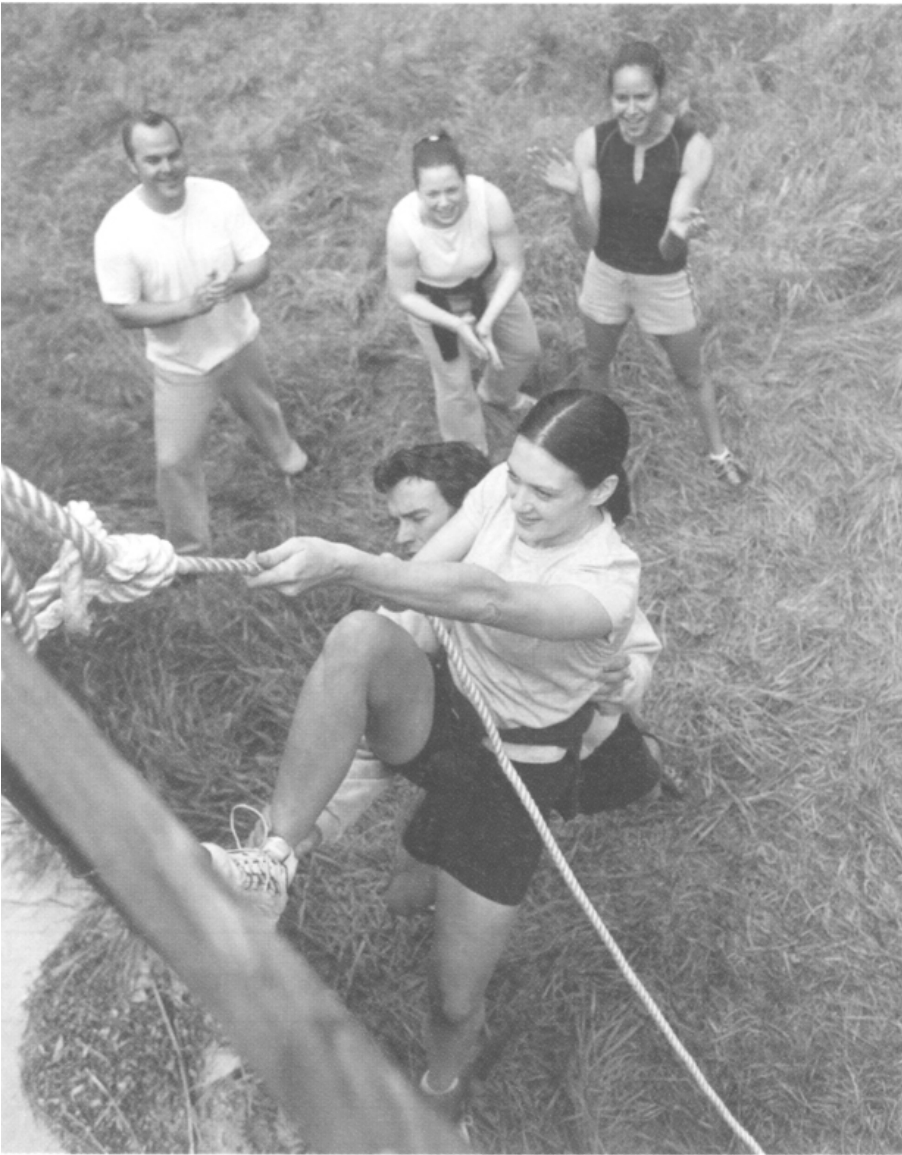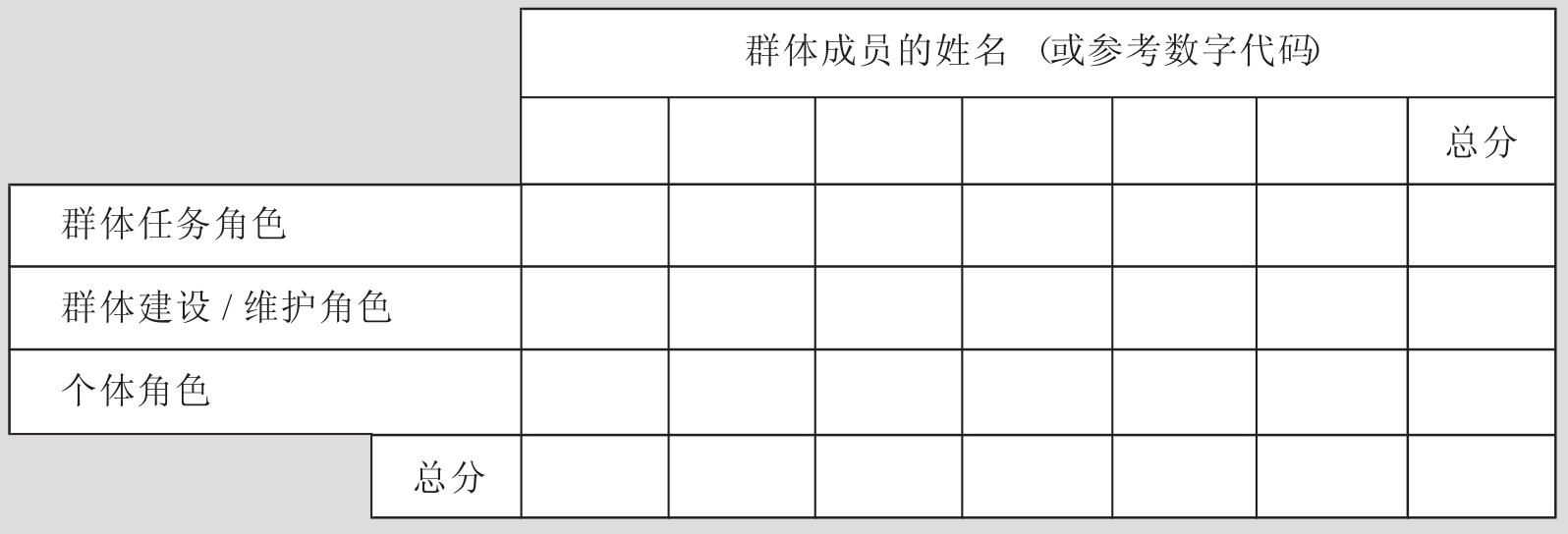小结14.2 消除障碍,塑造团队精神
那些认为“团队塑造”练习可以平息怒气的公司总裁们可能要停止这种观念了,因为在以下这则新闻里,Railtrack公司的一次聚会导致了一位高级经理因涉嫌酗酒行为而被留职察看。
但是,公司对联谊活动的知觉支持了一些“团队塑造”的练习——尤其迎合那些新兴的旅馆和管理顾问们,每年该项商务活动的价值达到了60000万英镑。
上周末,在Railtrack团队塑造练习中发生的各种酗酒行为激怒了位于Hampshire的Balmer Lawn酒店的职员和员工,并导致了该公司对国家合同部门负责人珀尔·怀特(Paul White)的停职处分。

图片:Jurgen Reisch Getty Images
在本月的早些时候,吉姆·霍金森(Jim Hodkinson)失去了在新 望这个时尚经销企业中担任总裁的工作,因为他在一次公司活动中对一名女性职员有性骚扰行为。
望这个时尚经销企业中担任总裁的工作,因为他在一次公司活动中对一名女性职员有性骚扰行为。
但是,在诺威奇(Norwich)的Dunston Hall这家经常接待公司聚会的酒店里,总经理罗兰·埃尔琳(Roland Ayling)对此并不惊讶。“当然,你让人们在饮酒中变得狂暴,”他说,“这是那天活动安排的一部分。”
虽然一些活动可能会失去控制,但是,一旦经理们与秘书们混在一起,办公室里的障碍就荡然无存了。这就是为什么企业总喜欢将大笔的资金花费在帮助员工增进相互了解之上,因为他们相信,这会有助于员工更有效地工作。
“在团队塑造活动中,员工们会展开以往从未有过的相互交往活动。”英国的贾森·勒德洛(Jason Ludlow)说道。上星期,该公司在新森林中为Railtrack的经理们组织了一次塑造团队的寻宝之旅。
但是,并不是每个人都赞同这个观点。批评家认为,很少有员工能将新的发展带回到办公室中。“没有人会忘记产生怨恨和分歧的地方,”前任Marks and Spencer公司的经理这样说道,他经历了许多联谊活动。“一旦重新回到繁杂的日常工作生活中,在这些活动中形成的共同使命感就会烟消云散。”一位广告经理补充道:“当人们感觉到有压力而去联谊时,他们就会远离这些活动并互相疏远。”
普遍的团队塑造活动包括寻宝、土鸽射击以及航海。有时还专门制作一些活动来影射公司的主要活动。例如,通过要求员工帮助街上的陌生人修理轮胎来训练他们的服务技能。也有一些经理质疑他们所参与活动的相关性。“事实是,我能够建造一个渡河的皮筏,并不意味着我就能够管理好员工。”爱德华·皮卡德(Edward Pickard)这样说道。在加入Tindall Riley公司以前,他在保险经纪公司Aon公司工作。
资料来源:Reproduced with permission from the Financial Times Limited,©Financial Times.
思考和问题讨论
1.试批判性地讨论在小型群体或团队中工作的可能优势和劣势,并提出支持你观点的实际事例。
2.对比不同类型的沟通网络,举例说明每种网络类型可能最有效发挥作用的情景。
3.评价个体行为分析对于经理的实际价值。试说明你怎样去构架一个社会关系图谱。
4.试区别:(1)群体任务角色;(2)群体建设和维持角色;(3)个体角色。对于以上每种群体成员角色,举出你自己的例子。
5.为群体情境中个体行为模式的分析和分类提出一个分析框架。在使用这些分析框架时,需要注意哪些方面?
6.试解释以下词语的意义:(1)“群体思维”;(2)风险转移现象;(3)头脑风暴。试与群体或团队绩效相对比,批判性地评估个体标准。
7.试解释敏感性训练的意义和目标。说明你自己对于群体机制的相关性和实践价值的看法。
8.详细描述在有效的团队工作中需要考虑的主要因素。
作业1
尝试着观察一个工作中的小型群体或项目,这是最好的方法;或者,也可以在下次进行小群体讨论时,观察你所在群体的各个成员。
1.(1)试解释群体讨论内容的本质,并将其与讨论过程相对比。
(2)完成以下表格,在适当的栏中打钩来表示个体成员行为的以下方面:
——群体任务角色;
——群体建设和维持角色;
——个体角色。

2.试解释你通过考察群体的行为和外在效益而得出的结论。
作业2
根据你自己在小型群体和/或项目团队中的工作经历,并按照导师的指导,试图完成以下任务中的至少两个。
任务1
试考虑个体成员如何最好地符合贝尔宾设计的九种团队角色(见表14.1)。
解释以下两个问题:
■他们特定的团队角色贡献;
■他们身上可以容忍的缺点。

人们的集体认识在多大程度上帮助形成了平衡、全面的团队角色列表,试对此进行批判性的评价。
任务2
分析成员间采取的沟通网络以及他们之间相互交流的水平(见图14.2)。对于群体中个体成员所经历的总体满意度水平进行批判性的评价。
任务3
根据对以下强调重点的不同对个体的成员角色进行分类:
■任务功能;
■维护功能;
■自我导向行为。
![]()

批判性地评论群体/团队成员间相互关系的整体结构或模式。
任务4
根据你对社会人际学的理解,私下向导师提供你所在群体/团队中的两个成员的名单,他们:
■最喜欢与你一道共度“狩猎旅行”这样的假日;
■在向你私下透露有关个人健康或保健困难时不会感觉到丝毫的不安;以及
■选择讨论你的学业或者工作进展。
任务5
对于群体/团队如何成功运作以及它对组织整体效益的贡献方面,给出你自己认为最能进行客观评价的判断指标列表。

作业3
在一个小型群体中工作,接受导师的指导,同时,采用头脑风暴方法来尽可能多地发现以下物品的用途:
■一份1970年版的、长达900页的美国教科书;
■一个男人或女人的皮带。
选出一个成员来记录你们提出的所有看法。在规定时间结束时,删除所有明显重复的观点,并对每个练习的各种思想进行汇总,然后准备与其他群体的观点和得分进行共享。
从这个作业中,你得出的结论是什么?

个人理解和技能练习
目标
完成这个练习将帮助你们加强以下技能:
■分析让大多数团队有效运作的角色。
■评估你在团队中扮演的角色。
■识别应该发展和更多地应用哪些角色来提高效益。
练习
参考以下概要表中的12种角色,你需要完成:
1.完成团队角色——自我评估表。
2.通过要求其他了解你的人完成你的团队角色——同事评估表,来提炼和修正结果。
3.对比各种结果开展讨论,来理解同事对你形成这种知觉的原因。
4.观察人们相互作用的方式,在你比较弱的角色上谁表现得比较强,并思考在哪些方式上,你能够运用自己的长处去帮助他人发展。
角色概要表
续表
团队角色——自我评估表
回顾角色概要表中的12种角色,并根据你扮演每种角色的频率对它们进行排序。
总结

团队角色——同事评估表
参考角色概要表的描述,根据你对人们扮演每个角色的强度进行排序。
从最强的角色1到最弱的角色12进行排序。

试评价,你认为以下方面的用处有哪些:
(1)发展弱势角色。
(2)使人们能够按照你认为有益于团队方式扮演角色。
讨论
■你在多大程度上赞同要使团队最为有效就需要有12种角色的观点。
■对你同事的团队角色评估表进行坦诚而批判的评价。他们的排序是否让你感到惊讶?
■你从这个练习中得出的结论是什么?
登录我们的网站www.booksites.net/mullins,以找到更多的问题、加注解的链接、案例材料以及网络研究材料。
注释与参考书目
1.‘Teamwork:Success Through People’,Advisory Booklet,ACAS,April 2003,pp.6-7.
2.See,for example:Allcorn,S.‘Understanding Groups at Work’,Personnel,vol.66,no.8,August 1989,pp.28-36.
3.Guirdham,M.Interactive Behaviour at Work,Third edition,Financial Times Prentice Hall(2002),p.463.
4.Obeng,E.All Change,Pitman Publishing(1994).
5.Crainer,S.Key Management Ideas:Thinkers that changed the management world,Third edition,Financial Times Prentice Hall(1998),p.238.
6.James,J.Body Talk at Work,Judy Piatkus(2001),p.211.
7.Belbin,R.M.Management Teams:Why They Succeed or Fail,Butterworth-Heinemann(1981).
8.Belbin,R.M.Team Roles at Work,Butterworth-Heinemann(1993).
9.Furnham,A.,Steele,H.and Pendleton,D.‘A Psychometric Assessment of the Belbin Team-Role Self-Perception Inventory’,Journal of Occupational and Organizational Psychology,vol.66,1993,pp.245-61.
10.Arroba,T.and Wedgwood-Oppenheim,F.‘Do Senior Managers Differ in The Public and Private Sector?An Examination of Team-Role Preferences’,Journal of Managerial Psychology,vol.9,no.1,1994,pp.13-16.
11.White,J.‘Teaming with Talent’,Management Today,September 1999,pp.57-61.
12.Fisher,S.G.,Hunter,T.A.and Macrosson,W.D.K.‘The Distribution of Belbin Team Roles among UK Managers’,Personnel Review,vol.29,no.2,2000,pp.124-40.
13.Bavelas,A.‘A Mathematical Model for Group Structures’,Applied Anthropology,vol.7,1948,pp.19-30,and Bavelas,A.‘Communication Patterns in Task-Oriented Groups’,in Lasswell,H.N.and Lerner,D.(eds)The Policy Sciences,Stanford University Press(1951).
14.Leavitt,H.J.‘Some Effects of Certain Communication Patterns on Group Performance’,Journal of Abnormal and Social Psychology,vol.46,1951,pp.38-50.See also:Leavitt,H.J.Managerial Psychology,Fourth edition,University of Chicago Press(1978).
15.Shaw,M.E.‘Communication Networks’,in Berkowitz,L.(ed.)Advances in Experimental Social Psychology,vol.1,Academic Press(1964).
16.Moreland,R.L.and Levine,J.M.Understanding Small Groups,Allyn and Bacon(1994).
17.Belbin,R.M.Changing The Way We Work,Butterworth-Heinemann(1997),p.13.
18.Stanley,T.J.‘The Challenge of Managing a High-Performance Team’,Super Vision,vol.63,no.7,July 2002,pp.10-12.
19.Moreno,J.L.Who Shall Survive?Beacon House(1953).See also:Moreno,J.L.and Jennings,H.H.The Sociometry Reader,Free Press of Glencoe(1960).
20.Rogers,E.M.and Kincaid,D.L.Communication Networks:Towards a New Paradigm for Research,The Free Press(1981),p.92.
21.Bales,R.F.‘A Set of Categories for the Analysis of Small Group Interaction’,American Sociological Review,vol.15,April 1950,pp.257-63.
22.Bales,R.F.Personality and Interpersonal Behaviour,Holt,Rinehart and Winston(1970).
23.Benne,K.D.and Sheats,P.‘Functional Roles of Group Members’,Journal of Social Issues,vol.4,1948,pp.41-9.
24.Coghlan,D.‘Managing Organizational Change Through Teams and Groups’,Leadership&Organization Development Journal,vol.15,no.2,1994,pp.18-23.
25.Whitfield,J.M.,Anthony,W.P.and Kacmar,K.M.‘Evaluation of Team-Based Management:A Case Study’,Journal of Organizational Change Management,vol.8,no.2,1995,pp.17-28.
26.Green,J.R.‘Team Building in Practice’,Chartered Secretary,November 1997,pp.34-5.
27.James,J.Body Talk at Work,Judy Piatkus(2001),p.212.
28.Kets de Vries,M.‘Beyond Sloan:Trust Is at the Core of Corporate Values’,in Pickford,J.(ed.),Financial Times Mastering Management 2.0,Financial Times Prentice Hall(2001),p.268.
29.Douglas,M.‘Why Soft Skills Are an Essential Part of the Hard World of Business’,Manager,The British Journal of Administrative Management,New Year 2003,pp.34-5.
30.‘Teamwork:Success Through People’,Advisory Booklet,ACAS,April 2003,p.31.
31.Kravitz,D.A.and Martin,B.‘Ringelmann Rediscovered:The Original Article’,Journal of Personality and Social Psychology,May 1986,pp.936-41.
32.See,for example:Karau,S.J.and Williams,K.D.‘Social Loafing:A Meta-Analysis Review and Theoretical Integration’,Journal of Personality and Social Psychology,October 1993,pp.681-706.
33.Hall,P.‘Team Solutions Need Not Be the Organisational Norm’,Professional Manager,July 2001,p.45.
34.See,for example:Blanchard,K.and Bowles,S.High Five:None of Us Is As Smart As All of Us,Harper Collins Business(2001).
35.Stanley,T.J.‘The Challenge of Managing a High Performance Team’,SuperVision,vol.63,no.7,July 2002,pp.10-12.
36.Guirdham,M.Interactive Behaviour at Work,Third edition,Financial Times Prentice Hall(2002),p.498.
37.Kogan,N.and Wallach,M.A.‘Risk-Taking as a Function of the Situation,the Person and the Group’,in Newcomb,T.M.(ed.)New Directions in Psychology Ⅲ,Holt,Rinehart and Winston(1967).
38.For a comprehensive review of the‘risky-shift’phenomenon,see,for example:Clarke,R.D.‘Group Induced Shift Towards Risk:A Critical Appraisal’,Psychological Bulletin,vol.76,1971,pp.251-70.See also:Vecchio,R.P.Organizational Behavior,Third edition,Harcourt Brace and Company(1995).
39.Shaw,M.E.Group Dynamics,Mc-Graw-Hill(1976).
40.Janis,J.L.Victims of Groupthink,Houghton Mifflin(1972)and Janis,J.L.Groupthink,Second edition,Houghton Mifflin(1982).
41.Hambrick,D.‘Putting the Team into Top Management’,in Pickford,J.(ed.),Financial Times Mastering Management 2.0,Financial Times Prentice Hall(2001),p.289.
42.Osborn,A.F.Applied Imagination:Principles and Procedures of Creative Thinking,Scribner’s(1963).
43.Diehl,M.and Strobe,W.‘Productivity Loss in Brainstorming Groups:Towards the Solution of the Riddle’,Journal of Personality and Social Psychology,vol.53,1987,pp.497-509.
44.See,for example:Bishop,S.and Taylor,D.Developing Your Staff,Pitman Publishing/Longman Training,(1994).
45.See,for example:Waterman,R.The Frontiers of Excellence,Nicholas Brealey(1994).
46.Cooper,C.L.and Mangham,I.L.(eds)T-Groups:A Survey of Research,Wiley(1971),p.v.
47.Luft,J.Group Processes:An Introduction to Group Dynamics,Second edition,National Press(1970).(The term‘Johari Window’was derived from a combination of the first names of the original authors,Joseph Luft and Harry Ingham.)
48.Davis,K.Human Behavior at Work,Fifth edition,McGraw-Hill(1977),p.183.
49.Davis,K.and Newstrom,J.W.Human Behavior atWork:Organizational Behavior,Eighth edition,McGraw-Hill(1989).
50.See,for example:McKenna,E.Business Psychology and Organisational Behaviour,Lawrence Erlbaum(1994).
51.For an overview of experimental small group methods and training needs,see,for example:Smith,P.B.Group Processes and Personal Change,Harper and Row(1980).See also:Brown,R.Group Processes:Dynamics Within and Between Groups,Basil Blackwell(1988).
52.Wilson,J.‘Building Teams-with Attitude’,Professional Manager,September 1998,p.13.
53.Browning,G.‘Brain Food:Matters for the Mind to Chew On’,Management Today,April 2000,p.20.
54.Riches,A.‘Emotionally Intelligent Teams’,Organisational Change&Leadership Development,www.anneriches.Com.au,accessed 11 March 2003.
55.Teamwork:Success Through People.Advisory Booklet,ACAS,April 2003,p.34.
56.South African Employment Equity Act,55,1998.
57.Belbin,R.M.Management Teams,Butterworth-Heinemann(1991);supported by a computer software package used under licence from Belbin and Associates.
58.Misselhorn,H.J.Understanding and Managing your Organization,M.O.D.Consulting(S.A.)(1998).
59.Misselhorn,H.J.The Head and Heart of Management,M.O.D.Consulting(S.A.)(2003).
60.Experiential learning refers to the learning that occurs from active first-hand involvement in the subject or task to be 1earned,plusmeaningful feedback to the learner from successful and unsuccessful understanding or performance.
61.These nine team roles were not developed from conceptualmodels but based on empirical observations by Belbin and his team over a number of years at Henleyon-Thames Management College.The terms used help to get away from the management jargon and find words which capture,in layman’s language,something of these typical behaviour patterns.
免责声明:以上内容源自网络,版权归原作者所有,如有侵犯您的原创版权请告知,我们将尽快删除相关内容。

















